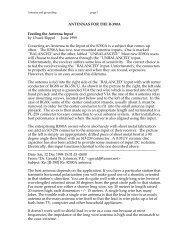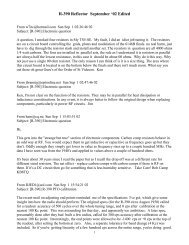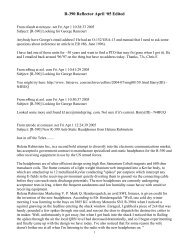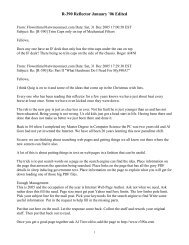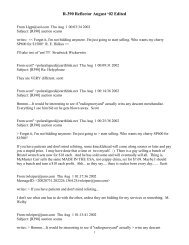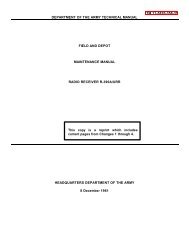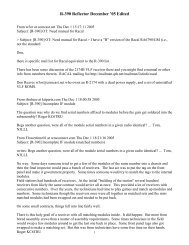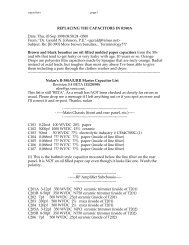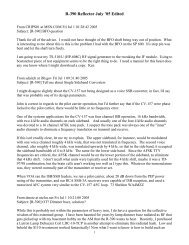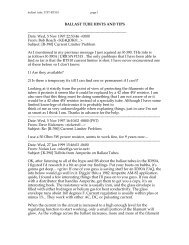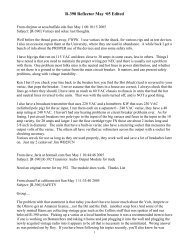Jul - The R-390A Frequently Asked Questions Page
Jul - The R-390A Frequently Asked Questions Page
Jul - The R-390A Frequently Asked Questions Page
Create successful ePaper yourself
Turn your PDF publications into a flip-book with our unique Google optimized e-Paper software.
switch positions to ground. Don't know if that is necessary, but the goal is to have all receivers fall<br />
absolutely silent when they are not connected to an antenna. One reason is to insure that the power line<br />
and local devices such as computers don't find themselves acting as signal sources.<br />
<strong>The</strong> only way I have discovered is use of balanced feeds into the receiver. I run unbalanced (coax) line<br />
to the set, then ground the coax shield to the receiver chassis, and connect a balun primary to the shield<br />
and center of the coax. <strong>The</strong> balun secondary is connected to the balanced inputs of the receiver. Short<br />
leads are very important.<br />
I use TV baluns (300-75 ohm) on some receivers where the AM band isn't very important. From<br />
measurements here, they don't work very well below 2.5 Mhz or so, and really dive below 1 Mhz. That<br />
can be an advantage, and usually the receiver gain can overcome performance on 1.8 Mhz, where 160<br />
meter operation appears normal. A homespun balun is used on the R-390 that works over a wider range<br />
of frequencies, in fact I am still suffering overload on the AM broadcast band. <strong>The</strong> antenna is a multiband,<br />
parallel dipole where 160, 80, 40, and 20 meter dipoles are all connected to a single RG-213<br />
feedline.<br />
<strong>The</strong> grounding system here should be ok, the radio room is only three feet or so above ground. I run 2-<br />
1/2" copper strap to two ground rods and to the house water pipe where it comes in from the street. <strong>The</strong><br />
house is old, so there should be metal at least to the meter.<br />
Receivers are dead on all bands except the AM broadcast band, where some stations can still make it<br />
weakly into a receiver (use Hallicrafters SX-62, HRO, BC-779, AR-88, R-390, TS-440)<br />
<strong>The</strong> question is can you silence your receivers by switching away the antenna, and if so, what approach<br />
to you take? 73 de Bill, AB6MT<br />
From terryo@wort-fm.terracom.net Sun <strong>Jul</strong> 7 19:19:59 2002<br />
Subject: [R-390] Twinax feedline available<br />
I have three pieces of twinax feedline with connectors. If anyone is interested I can measure them out<br />
and get back to you with a price. Best, Terry O'<br />
From dallas@bayou.com Sun <strong>Jul</strong> 7 20:28:48 2002<br />
Subject: [R-390] R-<strong>390A</strong> 10 dB S+N/N AM Sensitivity<br />
<strong>The</strong>re has been a lot of confusion about how to measure the AM sensitivity of an R-<strong>390A</strong>.<br />
Unfortunately the manuals have contributed to this confusion. <strong>The</strong> 1970 Navships 0967-063-2010<br />
manual has a sensitivity measuring procedure on pages 4-2 and 4-3 which involves setting the<br />
signal generator (URM-25D) to minimum output. This is equivalent to the method of turning the<br />
signal generator on and off which is used at several web sites to find the 10 dB S+N/N ratio.<br />
However, the Navships manual does not mention a 10 dB S+N/N ratio, but rather a 10 dB rise,<br />
which it is. What the Navships and web sites measure is the 10 dB S+N1/N2 where N1 is the nosignal<br />
receiver noise, and N2 is the noise due to the signal and receiver. Also, the 50 ohm<br />
impedance of the signal generator is not matched to the 125 ohm nominal (100 - 300 ohms)<br />
antenna input impedance (through a UG-636A/U and UG-971/U) of the R-<strong>390A</strong>. Consequently,<br />
the signal generator reading is not the number of microvolts that appears across the R-<strong>390A</strong><br />
antenna input. <strong>The</strong> Army manual TM 11-5820-358-35 gives a Sensitivity Test, not a procedure for<br />
measuring the 10 dB S+N/N ratio. <strong>The</strong> earlier Army manual TM 11-856A in paragraph 166 has<br />
what it calls an AM Sensitivity measurement procedure. However, there are at least two things<br />
20



